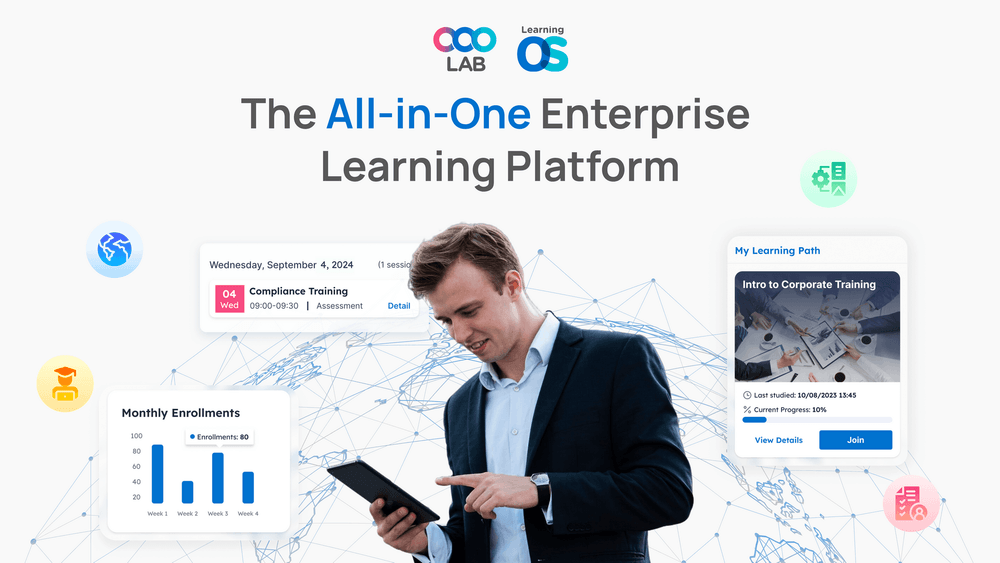

A Learning Management System (LMS) is a digital platform designed to deliver, manage, and track employee training programs at scale. In the context of Learning & Development (L&D), an LMS serves as the central hub for onboarding, upskilling, compliance training, and professional growth — streamlining how organizations deliver learning across teams, roles, and regions.
When implemented strategically, an Enterprise LMS not only supports the delivery of training but also aligns (1) learning initiatives with (2) business goals, making it a critical tool for driving workforce performance and long-term development.

>>> Read more: What is an Enterprise LMS?
>>> Read more: 3 Reasons Why an LMS for Learning and Development is Essential for Modern Workforce Training
Choosing the best LMS for Learning & Development programs isn’t about having the most features—it’s about selecting the right ones that align with (1) your business goals, (2) audience, and (3) growth plans. The next section outlines the essential criteria to guide your LMS selection that fits with (2) your audience and (3) growth plan.
>>> Read more: Employee Engagement Strategies for Your Enterprise LMS
For instance, if internal data shows that 80% of your workforce accesses training via iPads or mobile devices, your LMS must offer a mobile-responsive interface with seamless user experience across screens. A lack of mobile optimization could result in low engagement and poor course completion rates.
Before investing, outline what your training program needs most—be it certification tracking, interactive content, analytics, or integration with HRIS. An LMS that fits both your business goals and learner expectations will ultimately deliver better ROI and training effectiveness.
>>> Need more clarity? Check out our FAQ section to discover the sample template for LMS features evaluation
For insights on setting your implementation up for success that (1) align with your business goals, don’t miss the next guide: Best Practices for Implementing a Learning & Development LMS.
Once you've aligned your learning strategy with organizational goals and clearly defined your audience needs, the next step is evaluating what features your L&D LMS must deliver. This stage is about translating your planning into actionable selection criteria.
A user-friendly LMS interface isn’t just about visual appeal—it directly impacts how efficiently learners engage with content and how easily administrators manage training operations. Here's how a well-designed interface benefits both groups:
Perspective | How a User-Friendly LMS Interface Helps | Examples / Features |
Learners | Makes training easier to access and complete, increasing engagement and course completion rates | - Clear navigation menus - Personalized dashboards - Mobile-friendly layouts |
Helps learners see the relevance of training to their job and long-term career development | - Progress tracking - Skill-based learning paths - Certificates and badges | |
Encourages continuous learning by reducing friction and improving the overall experience | - Easy content discovery - Reminders & notifications - Self-paced learning | |
Administrators | Simplifies course management and content updates, saving time and reducing support queries | - Drag-and-drop course builders - User role controls - Bulk enrollment tools |
Enhances visibility into learner engagement and performance | - Real-time analytics dashboards - Training completion reports | |
Allows intuitive setup of custom learning paths that align with business goals | - Role-based access - Customizable learning |
An effective L&D LMS should seamlessly integrate with your existing tech stack—whether it's HR software, performance management tools, communication platforms, or content repositories. Strong integration capabilities ensure training isn’t siloed, but part of a broader ecosystem that supports performance, engagement, and data-driven decision-making.
Perspective | How Integration with Existing Systems Helps | Examples / Features |
Learners | Provides a unified experience where learning fits naturally into their daily workflows | - Single sign-on (SSO) for easy access - Learning embedded in productivity tools |
Saves time by auto-syncing learning data with HR or talent systems | - Completed training auto-updates learner records | |
Administrators | Reduces manual work by syncing data across systems like HRIS, payroll, or CRM | - Auto-enrollment based on employee role or department |
Enables better reporting by combining learning data with performance and productivity metrics | - API integrations with BI tools - Centralized dashboards | |
Helps align training efforts with broader business goals and workforce planning | - Integration with performance reviews or skills frameworks |
No two organizations have identical training needs—which is why a flexible L&D LMS must offer customization features and the ability to scale as your workforce grows. A platform that adapts to your brand, workflows, and long-term goals ensures a consistent learner experience and sustainable training operations.
Perspective | How Customization & Scalability Help | Examples / Features |
Learners | Provides a branded, personalized learning experience that reflects company culture and learning preferences | - Custom UI and branding - Role-based content delivery |
Supports different learning styles and job-specific training pathways | - Modular learning paths - Language localization | |
Administrators | Adapts easily to organizational growth or restructuring, without disrupting existing learning programs | - Tiered user management - Add-on modules |
Ensures the LMS remains relevant as training needs evolve | - Expandable course libraries - Flexible content formats (SCORM, xAPI, video, etc.) | |
Enables ongoing optimization with customizable reports and performance tracking | - Adjustable reporting fields - Configurable learner analytics |
>>> Read more: Customization Options for Enterprise LMS
>>> Read more: Must-Have Features in an Enterprise LMS in 2025
When managing sensitive employee data and proprietary content, security is non-negotiable. A reliable L&D LMS must offer strong protection measures to safeguard personal information, maintain compliance, and ensure the integrity of training records across your organization.
Perspective | How Robust Security Benefits Users | Examples / Features |
Learners | Protects personal data and learning history, creating a safe environment for professional development | - Data encryption - Secure login/authentication protocols |
Ensures confidence in the system when accessing learning materials from various locations or devices | - Multi-factor authentication (MFA) - Secure mobile access | |
Administrators | Prevents unauthorized access to course materials, user data, and performance reports | - Role-based access controls - Audit trails |
Supports compliance with global data regulations (e.g., GDPR, SOC 2, ISO 27001) | - Compliance certifications - Data retention policies | |
Minimizes operational risks and builds trust across teams and departments | - Regular security updates - Backup and recovery features |
With today’s hybrid and remote workforces, learning must happen anywhere, anytime. A modern L&D LMS should offer full compatibility across devices—ensuring learners have a consistent, productive experience whether they’re on a laptop, tablet, or smartphone.
Perspective | How Multi-Device Access Benefits Users | Examples / Features |
Learners | Empowers flexible, on-the-go learning—critical for field teams, remote workers, and busy professionals | - Mobile-responsive design - Dedicated apps for iOS/Android |
Encourages consistent engagement by removing barriers tied to location or device type | - Offline access mode - Sync progress across devices | |
Administrators | Expands learning reach without needing multiple tools or versions | - Central content delivery across devices |
Ensures accessibility and usability for a diverse workforce | - Cross-platform compatibility testing - ADA-compliant design | |
Simplifies support and improves user experience across different operating systems | - Unified platform updates - Device usage analytics |
A feature-rich LMS platform for Learning and Development is only as good as the team behind it. Choosing a reliable vendor with responsive support and a proven track record ensures long-term success—especially as your training programs evolve or encounter technical challenges.
Perspective | How Vendor Reliability & Support Services Help | Examples / Features |
Learners | Minimizes downtime and disruptions, ensuring consistent access to training materials | - 99.9% uptime guarantees - Timely issue resolution |
Provides fast support when learners face technical issues, preserving momentum in the learning process | - In-platform chat or help center | |
Administrators | Ensures smooth implementation, updates, and troubleshooting—reducing internal IT dependency | - Dedicated onboarding support - Knowledge base and live training sessions |
Supports long-term growth with roadmap visibility, scalability updates, and account management | - Regular feature rollouts - Strategic account consultation | |
Builds a partnership—not just a software contract—helping you adapt and optimize your learning programs over time | - SLA-backed service agreements - Customer success managers |
By carefully evaluating these core features—usability, integration, scalability, security, accessibility, and vendor support—you equip your organization to choose the best LMS for learning and development programs that deliver measurable results and evolve with your workforce’s needs.
>>> Read more: Steps to implemen an Enterprise LMS
>>> Read more: Strategies To Improve Team Skill Quotient
>>> Read more: How AI-Driven LMS Solutions Personalize Skill Development for Employees
Choosing the best LMS for learning and development programs isn’t just about selecting the platform with the most features—it starts with intentional planning. Understanding your organizational goals, aligning training with skills development, and knowing your learners’ needs are the foundation. From there, evaluating top LMS features for L&D teams, ensuring LMS integration with HR software, and prioritizing scalable LMS solutions become steps toward a system that truly supports continuous learning.
With a clear roadmap in place, the LMS you choose won’t just deliver training—it will drive business impact and empower your workforce to grow.
Book a Free Demo with us. Bring your Training and Learning to a new height with LearningOS.
 >>> Read more: Why is Employee Upskilling Non-Negotiable for Business Success
>>> Read more: Why is Employee Upskilling Non-Negotiable for Business Success
>>> Read more: Building Confidence in Your Sales Team Through Training and Development
>>> Read more: AI is Transforming Corporate Training: Here's What You Need to Know
>>> Read more: How AI is Enhancing Capability-Based Learning in LMS Platforms
>>> Read more: A Game-Changer for Measuring and Boosting Skill Quotient
At OOOLAB (pronounced 'uːlæb'), our mission is to make complex learning operations simple. We aim to positively impact the lives of over 1,000,000 learners and educators by the end of 2026.
OOOLAB's LearningOS provides educational institutions and corporate enterprises with an all-in-one solution to create and deliver engaging learning experiences.
We meet organizations' needs or support your growth. We provide undivided attention. We provide:
Dedicated success manager: We offer direct communication with a real human who'll discuss your enterprises unique learning operations and goals.
Personalized setup: Our team will help you transition to LearningOS on your schedule, one step at a time.
Around the clock support: Get help from us any time, and in any time zone.
Reach out to us at: LinkedIn, Facebook, Instagram, Tiktok, X
Step 1: Define Objectives
Start by clearly outlining your organization's learning and training goals. What specific skills or knowledge are you aiming to impart, and what measurable outcomes do you expect?
Step 2: Identify Your Target Audience
Understand who will be using the LMS—employees, customers, or both. Consider factors such as demographics, technical skill levels, and preferred learning styles.
Step 3: Content Analysis
Evaluate your current training materials. Identify content that can be reused and determine which parts need to be updated or created from scratch.
Step 4: Budget Analysis
Establish a realistic budget for your LMS project, including both initial implementation costs and ongoing expenses for maintenance, updates, and support.
Step 5: Technology Infrastructure
Assess your current IT infrastructure. Ensure it can support the LMS’s requirements, such as hardware, software, and network connectivity.
Step 6: Compliance Requirements
Identify any regulatory or industry-specific compliance needs your organization must meet. These may influence the features and functionality you require from your LMS.
Step 7: Growth and Scalability
Consider your organization's future growth. Ensure the LMS you choose can scale to accommodate a growing user base, expanding training needs, and additional content.
Here's a sample LMS Feature Checklist tailored for stakeholders, helping them evaluate options based on organizational needs. It’s categorized for clarity, with essential and strategic features clearly listed.
Feature | Reflect on Your Company’s Background and Goals |
Content Management | Does your organization need to manage diverse content types? How scalable is your content? |
User Management & Roles | How many users will the system support? Do you need complex role-based permissions? |
Robust Reporting & Analytics | What kind of metrics matter most to you? Are detailed reports essential for compliance? |
Scalability & Growth | Is your company expecting growth in users or courses? Does the LMS allow for easy expansion? |
Responsive Design & Accessibility | How important is mobile access for your workforce? Do you need compliance with accessibility standards? |
Customization Options | How much customization do you need for branding and learning paths? |
Assessment & Certification | Do you require certification for courses? How complex should assessments be (quizzes, tests)? |
Compliance Training Support | Are there specific compliance regulations you need the LMS to support (e.g., GDPR, HIPAA)? |
Integration with Existing Systems | What systems (HRIS, CRM, etc.) need to integrate with the LMS? Is single sign-on important? |
Learner Engagement Features | What engagement features matter most? (e.g., gamification, social learning, push notifications) |
3. Who currently uses your platform?
Our platform is currently used by over 120,000+ learners, parents, and employees across 21 countries worldwide!
4. What types of content options are available on your platform?
We offer ready-to-go curriculums for various educational purposes or our expert design team can build a custom course for you. We can also upload your existing learning materials and enhance them digitally.
5. What is unique about LearningOS?
Our platform, designed by educators for educators, provides you with all the tools you need to scale. Build and promote your own hybrid and blended learning courses and save money on licensing fees by owning your own proprietary content.
6. How can I get started?
Schedule a meeting with our experts and we’ll talk about how our platform can address your unique challenges and help to grow your business.